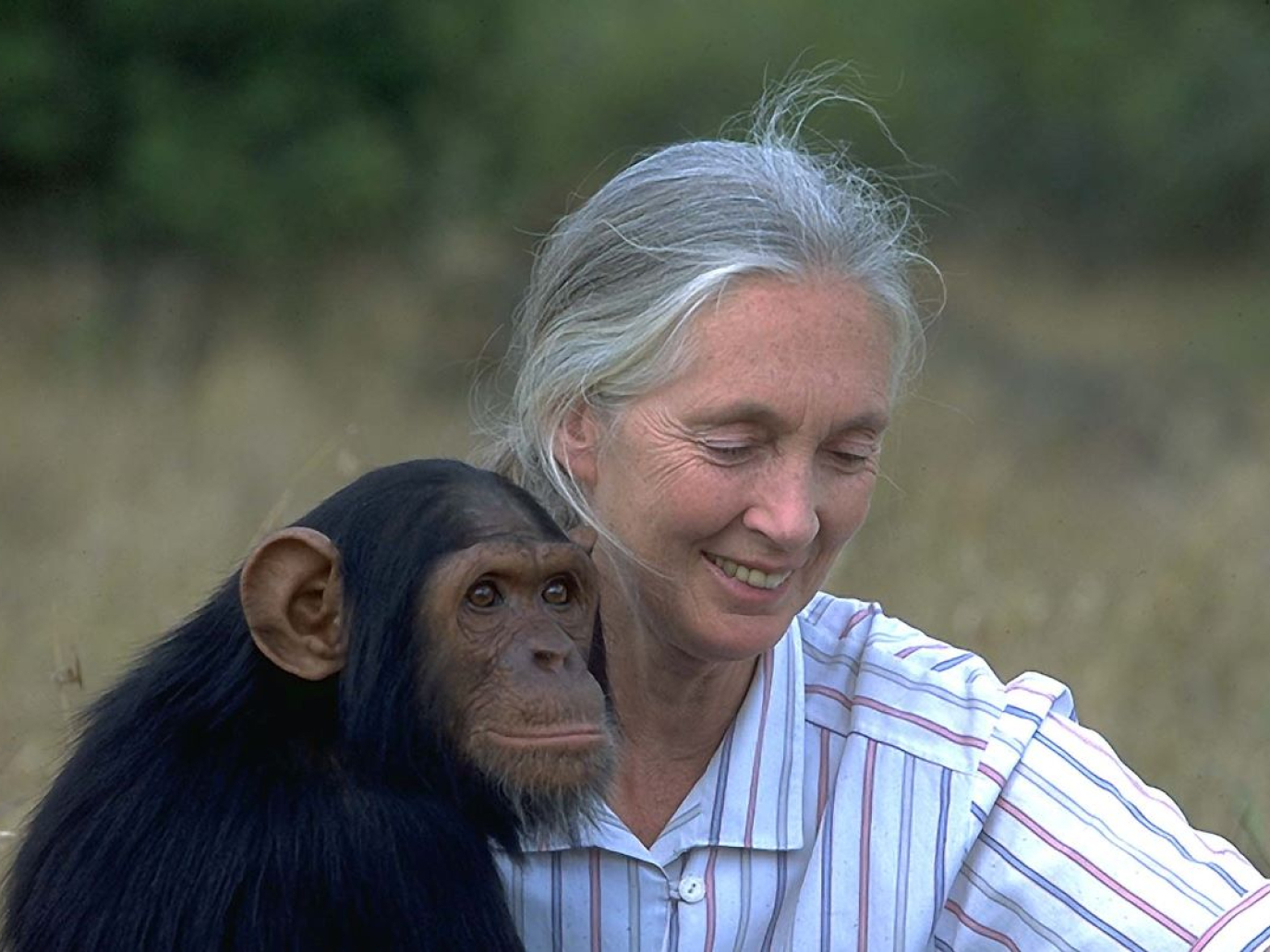
This article is also available in Italian / Questo articolo è disponibile anche in italiano
Republished below is the interview conducted in 2018 by Editor-in-Chief Emanuele Bompan to celebrate the invaluable work of the renowned British ethologist, anthropologist and writer Jane Goodall, died on 1 October 2025 at the age of 91. Known throughout the world for her studies on chimpanzees and her commitment to environmentalism, she spent her life researching and spreading knowledge about the social and family life of animals, starting with chimpanzees, working in Gombe Stream National Park.
Today marks the first World Chimpanzee Day. The date of 14 July was chosen as it is the day on which ethologist Jane Goodall, founder of the Jane Goodall Institute and United Nations Messenger of Peace, began her pioneering research on chimpanzees in what is now Gombe Stream National Park in Tanzania. It is one of the last sanctuaries for this species, our closest relative in the animal kingdom.
The aim of this day is to raise awareness of the serious risk of extinction facing this species. Today, there are fewer than 200,000 chimpanzees left in the world, 49 of which are in captivity in Italy, according to a census carried out by the Italian branch of the Goodall Institute [as of May 2025, the Goodall Institute counted 35 chimpanzees, 4 gorillas and 44 gibbons in Italy, ed].
“I hope you will join us on this very first World Chimpanzee Day to highlight the extraordinary nature of these beings and to shed light on the threats they face,” Jane Goodall begins the interview. “So, please, join us for them.”
Doctor Goodall, you have become a global environmental activist.
When I began studying chimpanzees in 1960, they were not an endangered species. The Gombe forest was part of what we called the equatorial forest belt, stretching from East Africa across the Congo Basin to the west coast. By 1990, Gombe had become a forest surrounded by bare hills, inhabited by more people than the land could sustain. That was when I realised that unless we helped the communities in the area, there would be no hope of saving the chimpanzees. So the Jane Goodall Institute launched Tacare (from “Take care”), a programme to support the local communities in economic development, environmental protection and birth control.
Since then, the Foundation has launched several initiatives for the planet.
And today we launched World Chimpanzee Day to halt the extinction of this species.
How were these primates viewed when you began your research?
Back in 1962, when I went to Cambridge for my PhD in ethology, scientists believed there was a substantial difference between humans and all other animals. They taught me to address the chimpanzees by numbers, not names. I could not talk about them as beings with personalities, with minds capable of thoughts and emotions: these were the prerogative of human beings. Yet my childhood mentor – my dog Rusty! – had taught me that this was not the case.
Even today, people forget that animals have feelings.
Chimpanzees are so similar to us, both biologically – the DNA composition of humans and these primates differs by about 1% – as well as psychologically and behaviourally. Science has begun to admit that, after all, we are not the only beings with personality, thought and emotions. Nor are we the only beings who use and make tools: I myself have observed chimpanzees using grass stems, sticks and leaves for numerous purposes.
What does Gombe, your field of study since you were 26, represent to you?
The best days of my life are associated with the time when I lived in the rainforest, alone with the chimpanzees, in a dim and peaceful world, where I could feel the interconnectedness of life. Where every species, no matter how small, played a role in the magnificent tapestry of life. Sitting next to a glorious 90-metre-high waterfall, caressed by the wind generated by the cascading water. The most spiritual place in Gombe.
When did you start looking at nature in search of its deepest meaning?
I spent my childhood observing the animals around my house: birds, squirrels, the occasional fox. I learned how important it was to be calm, avoid sudden movements, and be patient. When I arrived in Gombe, I spent the first few months observing the chimpanzees through binoculars. They would run away if I got too close. Because I always wore the same clothes and did not appear to be a threat, they eventually stopped being afraid, and I was able to sit peacefully near them. That is how I got to know them as individuals and gradually learned about their complex and fascinating behaviour.
When did you realise you had gained their trust?
I remember well when the old dominant female, Flo, finally accepted me to the point that she allowed her four-month-old infant, Flint, to approach me with eyes wide with wonder and touch me.
What was the most shocking discovery about these primates' personalities?
I was shocked – and very saddened – when I discovered that chimpanzees, just like us humans, had a dark, aggressive and vicious side that was intrinsic to their nature. Males are very territorial and often engage in actual wars with neighbouring communities.
Even going so far as to kill their own kind.
Within the community, however, they also demonstrate good conflict resolution skills: when threatened or attacked, the victim often approaches the aggressor and asks for a friendly gesture or a hug. At that point, harmony is restored.
We, on the other hand, are incapable of preserving the harmony of the planet. Megafauna is disappearing. Where have we failed in protecting the planet's biodiversity?
The biggest difference between humans and other animal species is the explosive development of our intellect. So how is it possible that the most intelligent creature to walk this planet could destroy its only home? What went wrong? It seems that we have created a disconnect between our brains and our hearts, which represent love and compassion. We make decisions based on immediate gratification. We have become enveloped in materialism. Gandhi said, “The planet can produce enough for humanity, but not for its greed.”
How can we take urgent action to protect the Earth?
There are three key problems to address: poverty; our unsustainable lifestyle, especially that of the wealthiest; and population growth. Let's think about the consequences of the choices we make every day. What do we buy, eat and wear? Has the production of this item damaged the environment? Does it cause animal suffering? Is it sustainable? When millions of people make ethical choices, then we begin to move towards a better world.
Can sustainable tourism be a strategy for protecting biodiversity and species such as chimpanzees?
Ecotourism, if properly managed by limiting the number of visitors, can have a positive effect. But it is important that locals also see the value in protecting the wilderness, and that governments benefit from the exchange. Many people say they have been completely changed after encountering elephants, chimpanzees and gorillas in the wild.
What is the Jane Goodall Institute doing to save the planet?
Thousands of young people are working to reduce humanity's environmental footprint through the JGI programme Roots & Shoots. Young people in 100 countries, from primary school to university, have formed around 1,500 groups, each of which chooses three projects to create a better world for people, animals and the environment. The Jane Goodall Institute Italy runs several Roots & Shoots projects with young people in both Italy and Tanzania, where it also runs an orphanage for the most vulnerable children.
Cover: Jane Goodall



